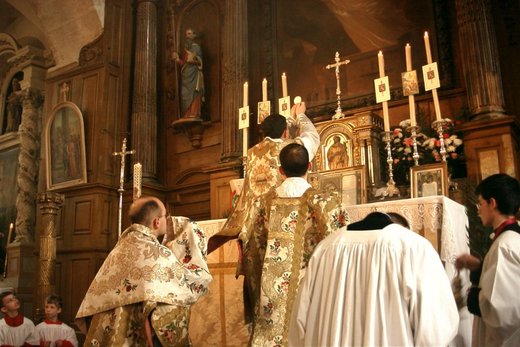Catholic Bucket List #2: Try a Tridentine Mass
Continuing my Catholic Bucket List series from the other day, this week’s suggestion is:
Bucket List Item #2: Attend a Tridentine Mass

A little background
So what’s a “Tridentine Mass”?
Well, when Joe Catholic attends a Mass today, he typically attends a “Novus Ordo” (“New Order”) Mass. This formulation of the liturgy was brought about in the Seventies through Pope Paul VI after the Second Vatican Council.
The Mass prior to the Novus Ordo looked quite different. Three distinguishing characteristics associated with this Mass were:
1. It was celebrated entirely in Latin. The Gospel reading would often be read in both Latin and in the native language. The homily would also be in the vernacular.
2. Everyone, including the priest, faced eastwards. This has often been unhelpfully described as “the priest with his back to the people”.
3. All females covered their heads (often with veils). This is an ancient practice which has its roots in Judaism and has New Testament support from 1 Corinthians 11:1-11.

If you would like to know more about the Tridentine Mass, I would invite you to read a couple of great posts by Msgr. Pope: “To Re-Propose Rather than Impose” and “Is the Old Latin Mass Charismatic?”.
Why on the Catholic Bucket List?
I’ve put this on the Catholic Bucket List because this is our Roman Catholic heritage. This is a more ancient form of the litury and this was the Mass celebrated by many of the Saints. I also think that, much like visiting an Eastern Catholic parish, attending a Tridentine Mass helps to foster an appreciation for liturgy and it gets us asking questions – why do we do what we do?
Plus, you never know, you might even enjoy it!
My Experience
I first experienced this formulation of the Mass about a year and a half ago. Rather than just attending a small Mass in a chapel somewhere, my first encounter with this form was at a Pontifical Solemn High Mass in the Basilica of the Immaculate Conception in Washington DC! I have since also experienced it on a smaller scale at St. Anne’s Church here in San Diego.
I had generally not heard many positive things about this older form of the Mass but, on the whole, my experiences have been positive. Like many people who are slightly sceptical of this form, I too was surprised by the number of of people attending, especially those in their 20’s and 30’s and those with young families.
Anyway, here’s my breakdown of things I liked and things that I wasn’t quite so keen on…
Appealing to the Masses…
Here were the things I really liked:
1. Kneeling
At the beginning, after the entrance procession, everyone kneels down and prays. I think this is a great way to begin Mass!
2. Facing Eastwards
I love it that everyone faces the same direction – the congregation is praying with the priest, awaiting Christ’s coming. It’s ancient, I love it and I want it back! (I’ll do a post sometime explaining the significance of facing eastwards)
3. Silence
In this form of the Mass there is much more silence, which I think is a good. In the Novus Ordo we usually only get silence after communion and it’s usually extremely short.
4. Communion Rail
Ironically, I first experienced receiving communion at a communion rail while attending an Anglican parish. I immediately preferred this style of reception. I particularly liked the fact that you have a little bit of time to prepare yourself beforehand and a little time afterwards prior to returning to your seat. Communion rails rock! Why on earth did we get rid of them?!!!
Mass Uncertainty…
These were the things I wasn’t so keen on:
1. Latin
While I can appreciate the universality of a single “sacred” language, and can imagine how wonderful it would be to attend an identical Mass while abroad, I’m not really sold on the Latin. If more people knew it I don’t think I would be opposed to having it back….but I’m not sure. Maybe my resistance is due to the horrors of learning Latin in school? Either way, I think I prefer to have Mass in the vernacular.
2. Lots of silent priest prayers
I’m not such a fan of this one either. After experiencing these Masses, I can understand why people said they felt disconnected from the activity on the altar. I found that constantly having to bounce between my missal and what was taking place rather annoying, although I’m sure this would lessen with familiarity. Still, I would like it if there weren’t quite so many silent prayers please…
3. Antiphonally Lacking
In the Novus Ordo (and Eastern Rites) there is quite a bit of back and forth between the priest and the people. Not so in the Tridentine form. Bah.
4. Singing
There seemed to be less singing in the Tridentine Masses I have attended. At the Low Mass there was none and, although there was quite a bit of music at the High Mass, although you could technically join in, it appeared to be sung almost exclusively by the cantor or choir. I want in!
Field Trip!
So…that was my impression. I liked some things, and with other things I had a little more trouble. Regardless, it was still a good thing to experience! If you have also experienced the Tridentine form, please feel free to share your impressions in the comment box below.
If you live in San Diego, have never been to a Tridentine Mass and would like to go, please drop me an email. It would be nice to do a group trip to St. Anne’s one Sunday.


Excellent review. I didn’t know about the facing East. Thanks for teaching that. I very much agree with your appealing and Mass Uncertainty points. I enjoyed the reverence, but I felt disconnected at the same time.
I’m glad you enjoyed it. The point of this Catholic Bucket List is to get Catholics to experience and appreciate the depth and breadth of the riches of the Church. I personally prefer the Novus Ordo over the Tridentine form, but my faith life is certainly richer for having experienced it.
I’ll try and put something together in the next few weeks about the significance of eastern orientation
Pingback: A few thoughts on head coverings | Catholic Defender Daily